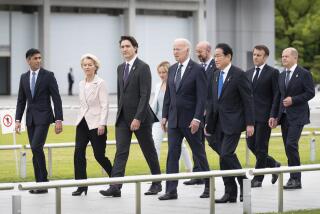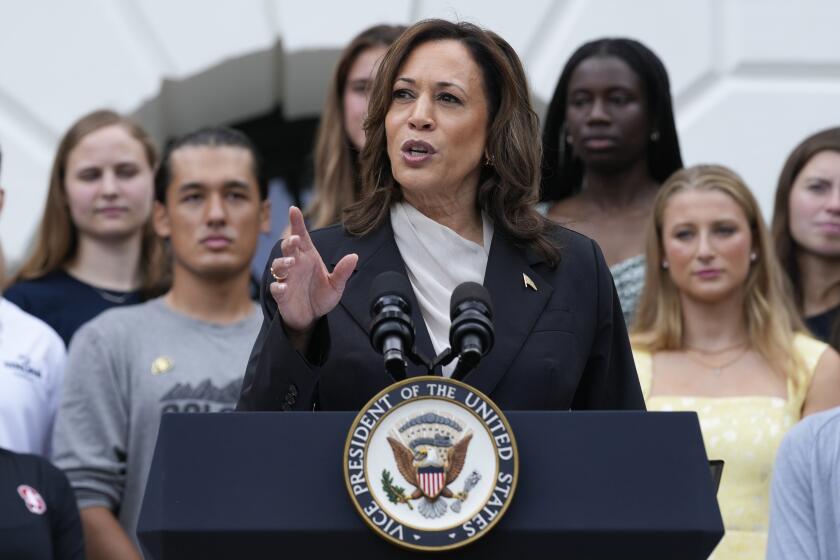Tribe Got Surplus U.S. Equipment : Indictments: Records show the Sioux never saw millions’ worth of gear ordered in its name.
To Russell Hawkins, the end of the Persian Gulf War was the beginning of a bonanza.
When the war ended in 1991, the federal government was swamped with heavy equipment it no longer needed. Hawkins, nearing the end of a decade as chairman of the Sisseton-Wahpeton Sioux Tribe, learned he could use the tribe’s name to get much of that equipment free.
During the next two years, prosecutors say, people linked to Hawkins got $63 million in government equipment, carting away machinery from earth movers to missile parts, all in the name of helping the unemployed among the 9,200-member tribe.
But records show the lion’s share of proceeds lined the pockets of Hawkins’ non-Indian business associates. The tribe never saw millions of dollars’ worth of gear ordered in its name. And it sold other equipment worth millions for a small fraction of its worth.
“It was basically organized crime,” said Steve Jackson, who worked briefly for the tribe in 1993 in a failed effort to clean up the program.
All the while, the Bureau of Indian Affairs watched the scheme unfold and didn’t stop it until this February. Although it’s the agency’s job to make sure Indian tribes run their affairs legally, BIA officials either ignored it or actively participated, records show.
“What they did by turning a blind eye to it was that they sanctioned it. They were aware because we told them about it,” said Andrew Laverdure, a top BIA administrator in Sisseton at the time.
Four men and one company have been indicted, and a federal probe continues.
*
In 1990, Hawkins hired Roger Raether to get surplus food and clothing for tribal members. Many Sisseton-Wahpeton Sioux live in poverty; in 1990, according to U.S. Census figures, tribal members had a median annual income of about $10,000 and an official unemployment rate of more than 23%.
When Raether discovered the tribe had no money to pay for shipping the material to the Lake Traverse Reservation, Hawkins suggested obtaining and reselling government equipment to raise money, Raether says in court records.
Thus was born Dakota Machinery Exchange.
Two non-Indians--Francis (Butch) Oseby and Donald Jerke, both of Sioux Falls--and tribe member Warren Barse formed the company in April, 1991, on the same day the tribe’s lawyer wrote to Hawkins saying the plans were legal.
Raether and Oseby would look for surplus equipment; the tribe would obtain it; DME would buy it from the tribe, paying pennies on the dollar for equipment worth millions.
For example, DME paid the tribe just $500 for a semi-truck tractor worth more than $68,000. That truck was part of about $10 million in government equipment seized from DME in a raid earlier this year.
Raether also turned a hefty profit from his dealings with the tribe. During 1992, Raether made more than $130,000 in commissions on the sale of government equipment, tribal records show.
Raether was amazed by the amount of money and equipment changing hands, but Hawkins assured him everything was legal, said Raether’s lawyer, Frank Denholm: “He couldn’t believe what was going on himself. But everybody was doing it.”
Raether traveled thousands of miles looking for equipment. In just the first week of February, 1992, for example, he logged 3,594 miles visiting military bases in Illinois, Tennessee, Arkansas, Texas, Oklahoma and Missouri.
He traveled in style on that trip, driving a purple 1991 Lincoln Town Car leased by Valley Systems Inc. of Canal Fulton, Ohio. Shelley Valentine, daughter of that company’s founder, was a player in the surplus enterprise as well, records show.
Records indicate Valentine--who has not been charged with any crime--used the Sisseton-Wahpeton tribe’s name to get at least $9.5 million in government equipment during 1991 for herself and her father’s company.
The equipment went to warehouses in northeast Ohio--more than 800 miles from the Sisseton-Wahpetons’ home in northeastern South Dakota.
During the first five months of 1992, Raether and Valentine got more than $134,000 from the tribe’s surplus equipment account.
Only about $21,000 from that account paid for work by tribal members.
*
Where was the Bureau of Indian Affairs during all of this?
Bureau official Laverdure noticed something was wrong, and repeatedly warned the agency over a four-year period. But his supervisors did nothing, and a frustrated Laverdure eventually took early retirement.
“The BIA has done that before. When something goes wrong, they let it go until it goes away by itself,” he said.
And prosecutors say one BIA official, Charles Hacker, was deeply involved in the scheme.
They say Hacker, then a transportation official in the BIA’s Albuquerque, N.M., office, provided hundreds of pre-signed equipment transfer forms that allowed Oseby, Raether and others to work without the usual BIA oversight.
In exchange, Oseby gave Hacker at least $7,000 in cash and offered him a $10,000 loan to buy a home, prosecutors say. Hacker admitted to federal agents that he took the payments, but insisted they were loans, not bribes.
Oseby also obtained a $500 stereo from an Air Force base in New Mexico and sold it to Hacker for $50, according to prosecutors.
The intrigue began unraveling in late 1992, when Lorraine Rousseau defeated Russell Hawkins in a tribal election by 12 votes.
Rousseau pledged to clean up corruption in the tribal government and took evidence of the scheme to federal prosecutors. She also hired two longtime Hawkins critics, Steve Jackson and Maynard Bernard, and told them to find a way to run the equipment program legally.
Bernard and Jackson were temporary employees, however, and were not rehired after about six weeks on the job. Rousseau says the tribe didn’t have enough money to pay them, while Jackson says he suspects Rousseau wanted to run the equipment program herself.
In the summer of 1993, the latest of several federal investigations of the scheme began bearing fruit. Hawkins became DME’s sales manager after he left office, and used his contacts with the Seminole Tribe of Florida to attempt similar equipment deals.
The scheme drew the attention of federal officials when Raether obtained a 300-ton crane for the Florida Seminoles from a naval yard in San Diego. Hawkins signed documents for the Seminoles selling the crane to DME for $34,000, and Jerke began trying to sell it. His price? $450,000.
The federal government’s property management agency, the General Services Administration, became suspicious. GSA official Peggy Lowndes called Raether to ask about the attempts to sell the crane, with federal agents listening in.
“I don’t know anything about that, OK?” Raether responded, according to court papers. “All I do is acquire the stuff for the Seminoles, OK?”
*
Raether and Jerke are charged with conspiracy and with lying to the GSA about the crane, which the GSA recovered before it left California. Oseby is charged with conspiracy and with bribery; Hacker is charged with bribe-taking. DME is indicted on charges of receiving illegally converted tribal property.
All have pleaded not guilty. Hacker’s trial is scheduled for January; the others are to go on trial in March.
Hawkins has not been charged. He declined repeated requests for an interview. His popularity appears to be unaffected by the scandal; he received 460 votes in his bid for a sixth term as chairman of the tribe, while Rousseau and Bernard tied for second place in the six-way race with 155 votes.
Rousseau and Bernard will compete in a runoff to face Hawkins in the general election Nov. 8.
More to Read
Sign up for Essential California
The most important California stories and recommendations in your inbox every morning.
You may occasionally receive promotional content from the Los Angeles Times.






